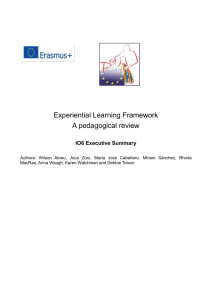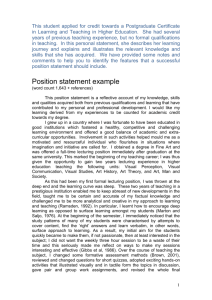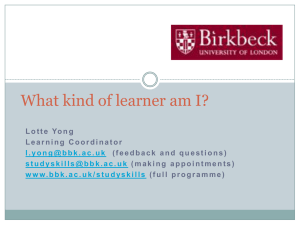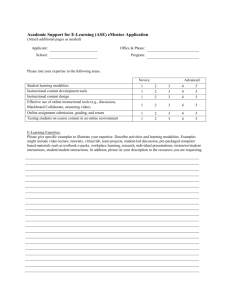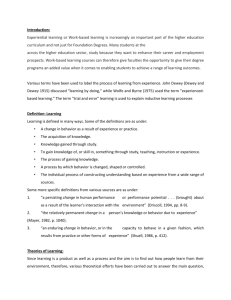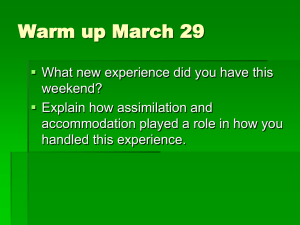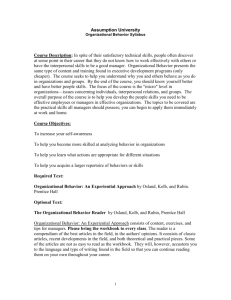Preparing e-Learning Designers Using Kolb`s - e
advertisement
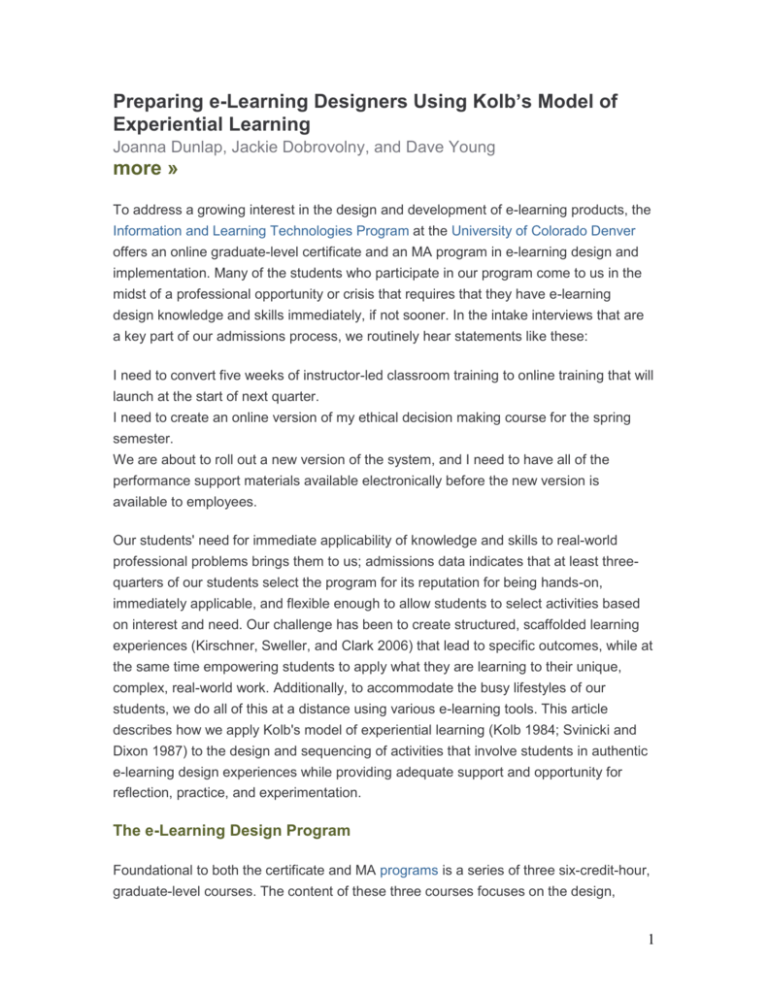
Preparing e-Learning Designers Using Kolb’s Model of Experiential Learning Joanna Dunlap, Jackie Dobrovolny, and Dave Young more » To address a growing interest in the design and development of e-learning products, the Information and Learning Technologies Program at the University of Colorado Denver offers an online graduate-level certificate and an MA program in e-learning design and implementation. Many of the students who participate in our program come to us in the midst of a professional opportunity or crisis that requires that they have e-learning design knowledge and skills immediately, if not sooner. In the intake interviews that are a key part of our admissions process, we routinely hear statements like these: I need to convert five weeks of instructor-led classroom training to online training that will launch at the start of next quarter. I need to create an online version of my ethical decision making course for the spring semester. We are about to roll out a new version of the system, and I need to have all of the performance support materials available electronically before the new version is available to employees. Our students' need for immediate applicability of knowledge and skills to real-world professional problems brings them to us; admissions data indicates that at least threequarters of our students select the program for its reputation for being hands-on, immediately applicable, and flexible enough to allow students to select activities based on interest and need. Our challenge has been to create structured, scaffolded learning experiences (Kirschner, Sweller, and Clark 2006) that lead to specific outcomes, while at the same time empowering students to apply what they are learning to their unique, complex, real-world work. Additionally, to accommodate the busy lifestyles of our students, we do all of this at a distance using various e-learning tools. This article describes how we apply Kolb's model of experiential learning (Kolb 1984; Svinicki and Dixon 1987) to the design and sequencing of activities that involve students in authentic e-learning design experiences while providing adequate support and opportunity for reflection, practice, and experimentation. The e-Learning Design Program Foundational to both the certificate and MA programs is a series of three six-credit-hour, graduate-level courses. The content of these three courses focuses on the design, 1 development, implementation, and evaluation of e-learning solutions using a variety of techniques and tools, with an emphasis on instructional design, interface design, facilitation strategies, and the Adobe Studio suite (Dreamweaver, Fireworks, and Flash, now sold together as Creative Suite 3, Web edition). The program starts twice a year (fall and spring), and we typically admit 25 to 30 students into each cohort. Our students work in a variety of educational settings; they are employed as K-12 teachers, college instructors, corporate trainers, instructional designers, technical writers, and performance technologists. Most of the students are novice online learners who have little or no experience with instructional design or Web site design and development. Because of the technical nature of the course content, the number of students participating, and the number of credit hours covered, two instructors co-teach each of these three foundation courses. Since these courses (and the entire program) are fully online, we use eCollege for student-to-student and student-to-instructor interactions and a supplemental public Web site for student-to-content interactions. In the first course in the program, Developing Educational Websites (recently renamed Designing and Teaching in e-Learning Environments), each student plans and designs an e-learning solution for his or her workplace or community. To encourage the development and application of the skills taught by the program, we require students to work on a real-world project. This project, referred to as the EdWeb project, is the focus not only of the first course, but also of all three foundation courses. Within this context, students design an educational Web site in the first course and then continue to build, modify, enhance, and add additional functionality in subsequent courses as they develop more advanced knowledge and skills. As part of the EdWeb project requirements, students complete a range of real-world activities based on conventional instructional design phases and processes. The first course includes the following steps, broken down into specific projects: 1. Describe the instructional problem to be solved. 2. Conduct a front-end analysis, including needs/opportunity assessment, audience analysis, and environment analysis. 3. Establish learning goals, objectives, and outcomes, and determine appropriate assessment methods. 4. Develop a project proposal that includes descriptions of appropriate learning activities. 5. Create a functional prototype, including interface and site design and site navigation. 6. Build a beta version of the educational Web site. 2 7. Develop an action plan outlining next steps, further development needs, appropriate technologies and tools, lessons learned, and future learning goals. Although each student works on a project individually, students are assigned to teams, which provide technical support, initial feedback, and encouragement to their members (Exhibit 1). We have found, however, that without significant support and structure, students may find working on real-world projects frustrating, ineffective, and demoralizing (Kirschner, Sweller, and Clark 2006). The transactional distance involved can make this especially true for students in online and distance programs, leading to attrition problems (LudwigHarman and Dunlap 2003). To preempt this challenge in our course, we used Kolb's model of experiential learning to structure and sequence the students' work on their realworld projects so that student frustration and the effects of transactional distance are minimized. Kolb's Model of Experiential Learning According to Kolb (1984), learning is "the process whereby knowledge is created through the transformation of experience. Knowledge results from the combination of grasping and transforming experience" (41). Kolb's experiential learning theory provides a framework for designing active, collaborative, and interactive learning experiences that support this transformational process (Bolan 2003; Kolb 1984). Experiential learning is a holistic process that has experience as its foundation and stimulus, and it actively involves students in constructing their experiences within the sociocultural context (Boud, Cohen, and Walker 1993). Influenced by Dewey, Lewin, and Piaget, Kolb (1984) conceptualizes learning from experience in terms of four components, each of which requires learners to invoke specific abilities: Concrete experience draws on the learner's willingness to experience new things; reflective observation requires an ability to consider experiences from a variety of perspectives in order to find meaning; abstract conceptualization requires an ability to analyze and integrate new ideas and concepts, drawing logical conclusions through reflective consideration of new experiences; and active experimentation requires learners to apply new learning to practice, problem solving, and decision making, which leads to new concrete experiences (Merriam, Caffarella, and Baumgartner 2006). These abilities are integrated into phases of a cyclical process referred to as the experiential learning cycle (Figure 1). Within the cycle each of these four components entails its own distinctive process for the learner: 3 1. Experiencing (concrete experience): The learner begins with an experience of a concept or situation. 2. Examining (reflective observation): The learner considers and examines the new experience from a variety of perspectives in order to find meaning. 3. Explaining (abstract conceptualization): The learner looks for patterns, builds concepts, and tests theories, considering what was learned and drawing logical conclusions about its future implications. 4. Applying (active experimentation): The learner draws upon previous insights to make decisions and apply concepts to new concrete experiences (Bolan 2003; Kolb 1984; Svinicki and Dixon 1987). The learning cycle may also be understood in terms of grasping and transforming experience; the grasping aspect of the cycle is represented by the activities of experiencing and explaining, and the transforming aspect of the learning cycle is represented by the activities of examining and applying (Kolb, Boyatzis, and Mainemelis 2000). In other words, there are two dimensions of the learning process. The vertical dimension—concrete experience to abstract conceptualization—represents learning from direct experience or from abstractions. The horizontal dimension—reflective observation to active experimentation—represents learning that occurs through reflecting on the experience or acting on the conclusions that have been drawn from the experience (Svinicki and Dixon 1987). The bottom line is that experiential learning emphasizes doing the task in order to learn it, which is a very context-based approach to the learning experience (Hansman 2001). Describing how experiential learning—and Kolb's model, in particular—can be used in instructional design, Svinicki and Dixon (1987) propose that certain commonly used teaching and instructional activities can support different phases of the cycle. They provide the following examples: To foster concrete experience, instructors can employ readings, examples, or laboratories. To foster reflective observation, instructors can assign journals, discussions, and brainstorming activities. To foster abstract conceptualization, instructors can provide model-building activities, assign papers, or deliver specialized lectures. To foster active experimentation, instructors can incorporate simulations, case studies, fieldwork, or final projects. 4 In this way, Kolb’s model provides a functional framework for selecting and sequencing learning activities that support students as they learn from experience while working on a context-rich, real-world project. Using Kolb's Model to Structure and Sequence Learning Activities Because instructional design activities are unfamiliar to many students and because we want them to complete the activities in an authentic manner, we need a way to scaffold performance. To this end, we turned to Kolb's model to help us think about the types and sequencing of activities in order to support students as they engage in authentic instructional design processes. To design the specific activities of the EdWeb project, we referred to Svinicki and Dixon's (1987) linking of specific teaching and instructional activities to the four phases of Kolb's cycle. To scaffold students' performance as they engaged in instructional design activities, we designed each activity to include the four phases of Kolb's experiential learning cycle so that students would engage in a continual cycle of experiencing, examining, explaining, and applying. To further scaffold students' performance, we utilized a collection of e-learning tools that facilitate experiential learning (Exhibit 2). In the following sections, we describe the application of Kolb's model to scaffold students as they complete two of the EdWeb project's main learning activities. Develop a Project Proposal For the EdWeb project, we want students to experience the professional practice of instructional design using conventional instructional design processes. Therefore, at the start of the project, students develop project proposals that require them to conduct front-end analyses. For this learning activity, students complete two full cycles of Kolb’s model: one for conducting the front-end analysis, and one for using the results from the front-end analysis to create the project proposal. Conducting the front-end analysis (Exhibit 3). At the start of this learning activity, students conduct a front-end analysis. Beginning with a concrete experience, they collect much of the information needed for their analyses via fieldwork, where they interview stakeholders, subject matter experts, and targeted learners. For the next phase of Kolb's model, reflective observation, students organize and examine their collected data to make initial speculations on the direction their projects need to take. Next, for the abstract conceptualization phase, students shared and discussed their findings in a threaded discussion forum where they considered how their findings will inform their design decisions, what additional information they need to collect, and how they will collect information that is difficult to gather. Finally, students take their findings and 5 compile them into a formal project proposal, which completes the front-end analysis with an active experimentation activity. Writing the project proposal (Exhibit 4). After completing their front-end analyses, students develop and complete a project proposal. Students first engage in a concrete experience by reviewing examples of effective and ineffective e-learning courseware. In threaded discussions, students then examine what made the courseware effective or ineffective in order to complete a reflective observation activity. For the abstract conceptualization phase of Kolb's cycle, students develop drafts of their project proposals, using what they have learned during their discussions and an outline with guided questions provided by us. Finally, for the active experimentation phase, students review each other's proposals and provide feedback, applying what they have learned about effective e-learning courseware to inform their comments and suggestions. Create a Functional Prototype After students revise their project proposals based on team and instructor feedback, they develop functional prototypes of their educational Web sites (Exhibit 5). First, students discuss a set of readings on and examples of functional prototypes; this activity involves them in a concrete experience. Students engage in reflective observation when they write a design rationale describing in detail what they need to do to ensure the functionality, clear navigation, and instructional flow of their projects. Students also read about and discuss the concept of iterative design and the importance of rapid prototyping. Typically, students use familiar tools, such as Word and PowerPoint, to develop their prototypes. For the abstract conceptualization phase, teams of students meet with the course instructors via a synchronous chat to explain and discuss their prototype plans and ask specific questions about their prototypes. Students then test the effectiveness of their design decisions by conducting a formative evaluation of their prototypes; at this point they rely on the feedback of their teammates, who use the same checklist they have used to evaluate other Web sites throughout the semester. This formative evaluation, the final team activity of the first course, completes Kolb's cycle with an active experimentation activity. Kolb's Model and Student Engagement Using Kolb's model of experiential learning to structure students' online learning activities also helps us attend to critical issues of online student engagement and satisfaction. Alley and Jansak (2001) have identified ten quality assurance factors that impact student engagement and satisfaction during online learning experiences: 6 Knowledge is constructed. Students are responsible for their own learning. Student motivation is a strong determinant of the outcomes and success of learning. Higher-order learning requires reflection. Learning is unique to the individual. Learning is experiential. Learning is both social and private. Inexorable epistemological presumptions can misdirect higher order learning. Learning is spiral (cyclical). Learning is messy. All ten of these factors are addressed by experiential learning and are reflected in our design decisions for the EdWeb project. For example, because students select their own real-world projects, they have responsibility for their own learning and their motivation to learn is enhanced. The individual and group instructional strategies we select for each project activity put students in the role of actor as opposed to receiver (Svinicki and Dixon 1987), encouraging active knowledge construction and higher order learning. Following Svinicki and Dixon's (1987) recommendations for creating effective experiential learning activities and using appropriate e-learning technologies and tools to support those activities, we also avoid the problems sometimes associated with minimalguidance instructional approaches to experiential learning (Kirschner, Sweller, and Clark 2006). Kolb's model of experiential learning helped us select and sequence appropriate instructional activities to create an e-learning experience that effectively engages students in the learning process and leads to a high level of student satisfaction, as reflected in students' end-of-course comments regarding the value of the EdWeb project (Exhibit 6). Conclusion We are encouraged enough by the results of using Kolb's model that we have added another experiential project to the program. In addition to launching the EdWeb project in the Developing Educational Websites course, students now design, formatively evaluate, and deliver to an audience of learners a two-week Web conference during the second course of the program. The Web conference, focused on tools and strategies for elearning, gives students an opportunity to develop and facilitate an e-learning experience for an actual audience. 7 Our instructional goal for the Developing Educational Websites course and the entire program is to prepare students to work as e-learning designers and specialists. Because many of our students are already involved in projects that require e-learning expertise when they start the program, we need to engage students in course projects and learning activities that allow them to work on their real-world projects while providing adequate support for learning and performance. By applying Kolb's experiential learning cycle to the instructional design of each component of the project—reflecting that learning is experiential, cyclical, and context-based—we achieve an effective experiential e-learning sequence for our students. References Alley, L. R., and K. E. Jansak. 2001. Ten keys to quality assurance and assessment in online learning. Journal of Interactive Instruction Development 13 (3): 3-18. Bolan, C. 2003. Incorporating experiential learning theory into the instructional design of online courses. Nurse Educator 28 (1): 10-14. Boud, D., R. Cohen, and D. Walker. 1993. Introduction: Understanding learning from experience. In Using experience for learning, ed. D. Boud, R. Cohen, and D. Walker, 117. Buckingham: Society for Higher Education and Open University Press. Hansman, C. 2001. Context-based adult learning. New Directions for Adult and Continuing Education 89: 43-51. Kirschner, P., J. Sweller, and R. C. Clark. 2006. Why minimal guidance during instruction does not work: An analysis of the failure of constructivist, discovery, problembased, experiential, and inquiry-based teaching. Educational Psychologist 41 (2): 75-86. Kolb, D. A. 1984. Experiential learning: Experience as the source of learning and development. Englewood Cliffs: Prentice-Hall. Kolb, D. A., R. E. Boyatzis, and C. Mainemelis. 2000. Experiential learning theory: Previous research and new directions. In Perspectives on cognitive, learning, and thinking styles, ed. R. J. Sternberg and L. F. Zhang, 227-247. New York: Lawrence Erlbaum. Ludwig-Hardman, S., and J. C. Dunlap. 2003. Learner support services for online students: Scaffolding for success. The International Review of Research in Open and 8 Distance Learning 4 (1) . http://www.irrodl.org/index.php/irrodl/article/view/131/211 (accessed November 14, 2007). Merriam, S., R. Caffarella, and L. Baumgartner. 2006. Learning in adulthood: A comprehensive guide, 3rd edition. San Francisco: Jossey-Bass. Svinicki, M. D., and N. M. Dixon. 1987. The Kolb model modified for classroom activities. College Teaching 35 (4): 141-146. 9
